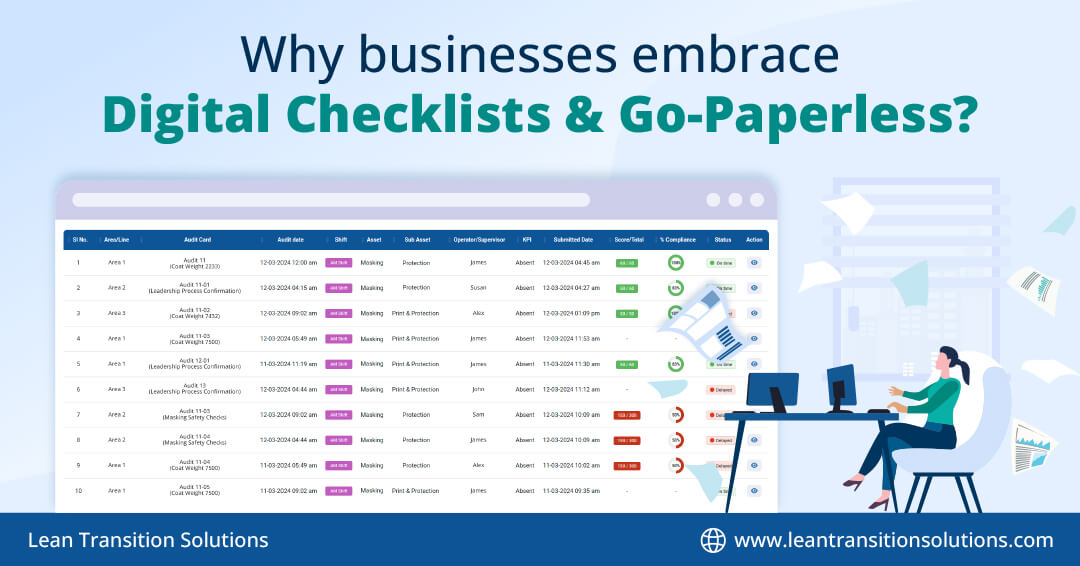Why businesses embrace Digital Checklists and Go-Paperless?
April 1, 2024
Organisations that resist digitalisation spend around 50% of employee time searching through paper files to gather data for audits. Many businesses often struggle to manage and store their paper records, including task details, workflow details or quality inspection audit details. Digital checklists have revolutionised traditional paper-based audits, enhancing efficiency, accuracy, and accessibility.
However, the challenge lies in replacing paper checklists in your industry while maintaining control over critical data. Understanding the best practices for transitioning from paper checklists to digital to-do list templates is crucial for manufacturers overseeing shop floors with numerous manufacturing processes and associated data.
Digital Checklists: Paving the way for efficiency
A digital checklist or digital planner serves as a visual aid, offering reminders and facilitating task prioritisation and scheduling to ensure deadlines are met on time. It provides a streamlined platform for organising tasks, allowing users to visually track progress, allocate resources efficiently, and maintain accountability across various projects or workflows. By digitising the checklists, individuals or teams can access, update, and collaborate on tasks in real-time, fostering enhanced productivity and adherence to standards. Digital checklists often feature customisable options, notifications, and integrations with other digital solutions, enabling seamless task management and process optimisation in diverse industrial settings.
Challenges of using Paper Checklists
Paper checklists have several limitations, and replacing it with a digital to-do list template is essential for organisations seeking to enhance operational efficiency and optimise task management processes. Transitioning from paper checklists to electronic checklists saves time and improves data accuracy and accessibility. Manufacturers can centralise audit data by implementing a digital checklist or digital planner, making tracking and analysing information easier for compliance and performance improvement purposes.
Data Loss
- Paper checklists are susceptible to loss or damage, compromising critical information integrity.
- Lack of backup mechanisms increases the risk of permanent data loss in incidents like fire or natural disasters.
- Incomplete or illegible entries contribute to data loss, hindering comprehensive record-keeping.
Lack of Accessibility
- Paper checklists are often confined to physical locations, limiting accessibility for remote or dispersed teams.
- Retrieving specific information from paper documents can take time and much effort, leading to delays in decision-making processes.
- Accessibility challenges restrict real-time collaboration and timely access to essential data.
Inefficient Workflow Management
- Manual handling and processing of paper checklists contribute to inefficiencies in workflow management.
- Lack of automation results in repetitive tasks, leading to productivity bottlenecks and resource wastage.
- Paper-based workflows are prone to errors and inconsistencies, impeding seamless task execution and progress tracking.
Hidden Costs
- Recurring costs for paper, ink, and printer maintenance contribute to printing expenses.
- Expenses related to physical storage facilities and document management systems add to the overall costs.
- Penalties and fines can result from incomplete or inaccurate record-keeping due to non-compliance with regulatory requirements.
Why should you go Digital?
Why do businesses make a switch to Digital Checklists? Let's check in detail the numerous benefits of going digital from streamlining processes to increased efficiency.
Enhanced Efficiency: Digital checklists streamline task management processes, reducing manual effort and minimising errors. Automation features such as reminders and notifications ensure timely task completion, improving overall workflow efficiency.
Improved Accessibility: Electronic checklists can be accessed from anywhere, on any device, enabling remote collaboration and real-time updates. This real-time accessibility ensures that team members can stay engaged and informed regardless of their location.
Real-Time Updates: With digital checklists, changes and updates can be made instantly, ensuring everyone can access the most up-to-date information. This facilitates better communication and decision-making within teams.
Customisation Options: Digital to-do list templates offer flexibility in customisation, allowing users to tailor checklists to specific project requirements or organisational needs. Customisable fields, templates, and categories enable efficient organisation and tracking of tasks.
Centralised Data Management: Electronic checklists centralise data storage and organisation, eliminating the need for multiple paper copies or dispersed documents. This centralised approach enhances data integrity, accessibility, and security.
Integration Capabilities: Many digital checklist platforms, such as project management software or communication systems, integrate with other platforms. This integration streamlines workflows and promotes seamless collaboration across different tools and teams.
Comprehensive Reporting: Digital checklists often include reporting features that allow users to generate comprehensive reports and analytics. These insights provide valuable performance evaluation, process improvement, and decision-making data.
Audit Trail: Electronic checklists maintain a detailed audit trail of all activities and changes, providing transparency and accountability. This audit trail helps track progress, identify bottlenecks, and ensure compliance with regulatory requirements.
Environmental Sustainability: Digital checklists contribute to environmental sustainability efforts by reducing paper use and minimising printing. This eco-friendly approach aligns with corporate social responsibility initiatives and reduces carbon footprint.
How do you replace Paper Checklists without losing control of Critical data?
By following these effective steps, organisations can successfully transition from paper checklists to digital checklists, realising the benefits of improved efficiency, accuracy, and accessibility in their operational processes.
Assessment and Prioritisation: Evaluate paper checklists for digitisation based on operational impact, compliance, and data sensitivity.
Selection of Digital Tools: Research and choose digital checklist software aligned with organisational needs, focusing on user-friendliness, customisation, integration, and security.
Migrating Data: Develop a systematic approach for accurate data migration from paper to digital, ensuring data integrity.
Customisation and Configuration: Customise digital checklist templates to mirror paper formats, aligning fields, categories, and workflows with specific business processes.
Training and Adoption: Provide comprehensive training for effective use, fostering a culture of digital adoption and stakeholder participation.
Integration with Existing Systems: Integrate digital checklist software with existing systems to streamline workflows and enhance data sharing.
Security and Compliance: To protect sensitive information, implement robust security measures, including user authentication, data encryption, and access controls.
Continuous Improvement: Solicit user feedback for iterative updates and enhancements to optimise functionality and user experience over time.
Managing Workflows: Tcard as your Digital Planner
T card is a visual management tool that acts as a digital planner or electronic checklist, facilitating task management, process control, and quality assurance on your shop floor.
Tcards provide a visually interactive dashboard for managing, tracking, and monitoring tasks or workflows, ensuring prompt and effective task completion within an organisation. Here's how Tcards can act as an electronic checklist on your shop floor.
Visual Representation: Tcards visually represent tasks, processes, or activities that must be completed. Each card typically represents a specific task.
Digital Work Instruction: Tcards serve as digital versions of operational procedures, such as work instructions, product specifications, work order information, quality manuals and SOPs (Standard Operating Procedures), with the real-time updates to guide workers through complex tasks with visual aids to obtain accuracy.
Task Tracking: As tasks are completed or progress is made, the corresponding Tcards are moved across columns to indicate the current status. This visual indication helps teams easily track task completion, identify deadlines, and blocked tasks.
Process Confirmation Audits: Tcards streamline process confirmation audits by visually representing tasks and ensuring adherence to predefined standards or procedures.
Quality Assurance: By using Tcards as checklists, organisations can enforce quality assurance measures and ensure that tasks are performed accurately, reducing the risk of errors or defects.
Gemba Audits: Tcards facilitate Gemba audits by providing a structured format for on-site observations and assessments, identifying improvement areas and ensuring alignment with operational standards.
Data Storage: Tcards offer a centralised platform for storing task-related data, documentation, and progress updates. This centralised repository enhances data accessibility, collaboration, and historical tracking for future reference and analysis.
Continuous Improvement: Tcards also support continuous improvement initiatives by providing a mechanism for identifying areas of improvement, tracking performance metrics, and implementing corrective actions as necessary.
Transitioning from paper checklists to digital checklists is not just about embracing modern technology but revolutionising how organisations manage their workflows and operations. Digital planners and to-do list templates provide a structured approach for managing tasks and scheduling activities, offering a more organised alternative to traditional paper-based methods.
Manufacturers who adopt a digital planner or an electronic checklist can significantly enhance productivity and manage their workflow without a missed deadline. With an editable checklist that supports shop floor progress, workers can efficiently manage tasks and track progress, reducing the time spent on paperwork and enhancing overall productivity.
If your organisation still relies on paper checklists for critical tasks such as audits, Gemba walks, or process confirmation, it's time to go-paperless and embrace digital checklists. Transitioning to digital to-do lists templates or planners can streamline workflows, enhance data accuracy, and increase visibility into your day-to-day shop floor operations.
